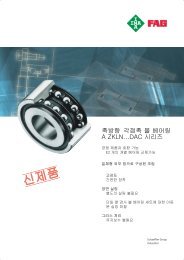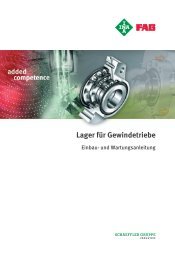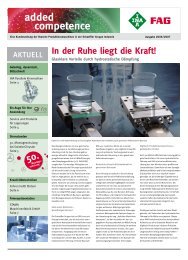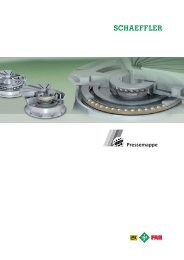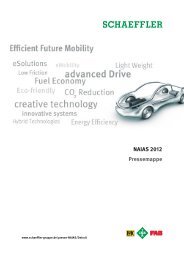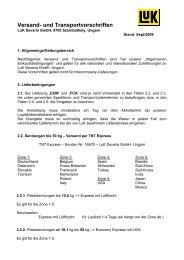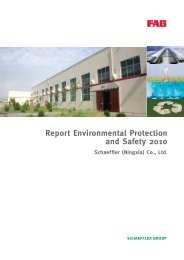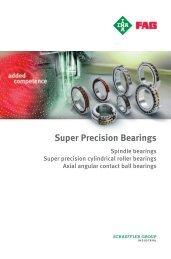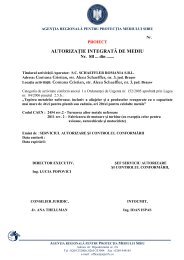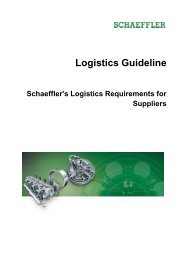Double clutch
Double clutch
Double clutch
Create successful ePaper yourself
Turn your PDF publications into a flip-book with our unique Google optimized e-Paper software.
Figure 7 <strong>Double</strong> <strong>clutch</strong> with small internal ratio<br />
plied by the <strong>clutch</strong> ratio. This change in travel<br />
must be taken into consideration in the design<br />
of the engage system. The disadvantage of this<br />
solution, however, is that the engage forces are<br />
higher due to the small <strong>clutch</strong> ratio, so that only<br />
engine torques of up to approx. 150 Nm can be<br />
handled while maintaining acceptable actuation<br />
forces.<br />
Actively closed <strong>clutch</strong>es with wear<br />
adjustment by load sensor LAC<br />
(Load Adjusted Clutch)<br />
About 15 years ago, LuK started on the development<br />
of adjusters for dry vehicle <strong>clutch</strong>es in<br />
order to mechanically compensate wear of<br />
<strong>clutch</strong> linings. A core system resulting from<br />
Figure 8 <strong>Double</strong> <strong>clutch</strong> with load-controlled wear adjustment LAC (Load Adjusted Clutch)<br />
LuK SYMPOSIUM 2006<br />
<strong>Double</strong> <strong>clutch</strong> 9<br />
this development work is the self-adjusting<br />
<strong>clutch</strong> SAC [1-4], which has been in volume<br />
production for approx. 10 years and is fitted<br />
in many fully manual and automated manual<br />
transmissions. It seems logical to apply<br />
this proven technology to dry double <strong>clutch</strong>es<br />
as well. In order to fulfil the specific requirements<br />
relating to double <strong>clutch</strong>es, such as<br />
actively closed <strong>clutch</strong>es and the highly restricted<br />
design envelope for the two <strong>clutch</strong>es and<br />
two actuation systems, it was necessary to<br />
develop the system further. A double <strong>clutch</strong><br />
system based on the load sensor principle has<br />
now been developed that has passed all the<br />
necessary function and endurance tests (Figure<br />
8).<br />
In order to achieve wear adjustment in the LAC,<br />
the lever spring of each sub<strong>clutch</strong> is subjected<br />
to an axial abutment or sensor load by a sensor<br />
spring. In addition, both lever springs are supported<br />
on the <strong>clutch</strong> cover by means of a<br />
ramped ring. The <strong>clutch</strong> cover provides the<br />
opposing ramps on both sides, a particularly<br />
compact design. As in the self-adjusting <strong>clutch</strong><br />
(SAC), wear is detected through the change in<br />
lever spring force by the sensor spring and<br />
compensated by the rotating ramp ring. Wear<br />
adjustment is completely automatic, free from<br />
overtravel and in very small increments, so no<br />
additional demands are made on the automated<br />
<strong>clutch</strong> control system. Both <strong>clutch</strong>es can<br />
thus be matched so that the lever spring position<br />
remains almost unchanged despite the<br />
wear and the<br />
required axial travel<br />
for the complete system<br />
is minimised on<br />
the <strong>clutch</strong> side. However,<br />
there is a very<br />
long tolerance chain<br />
from the <strong>clutch</strong> lever<br />
spring fingers to the<br />
actuator system that<br />
requires compensation<br />
of tolerances<br />
through shims specific<br />
to the transmission.<br />
In order to<br />
avoid this time-consuming<br />
process in<br />
automotive assembly<br />
plants, intensive<br />
125



